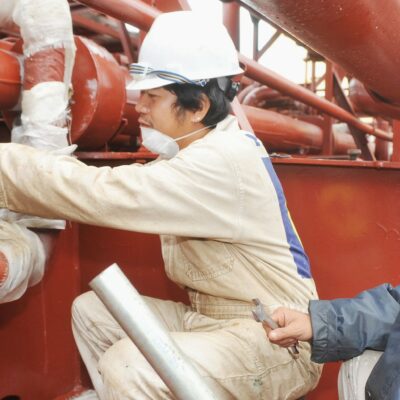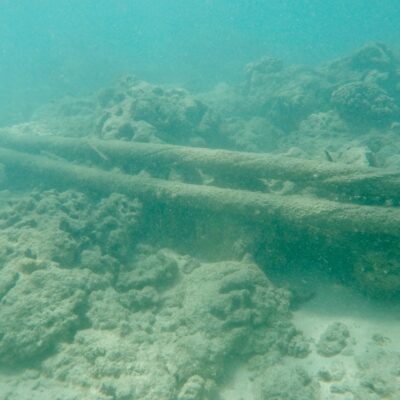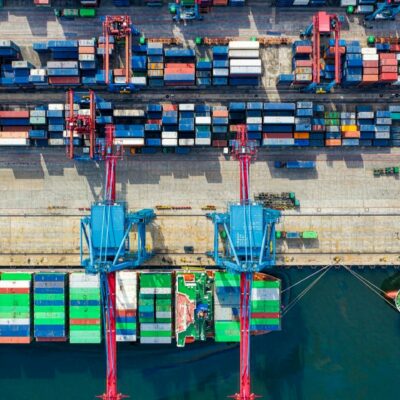This Blue Security/Melbourne Asia Review series ‘Beyond the South China Sea: other maritime disputes in Southeast Asia’ provides context and clarity to the numerous unresolved maritime boundary disputes in Southeast Asia. This series seeks to discuss and dissect regional maritime boundary disputes outside the prominent disputes within the nine-dash line of the South China Sea. The successful and timely resolution of all regional maritime disputes are important to claimant states and the broader region as geopolitical tensions in maritime Southeast Asia remain significant. A central focus of the series is on developing positive steps to reinforce the region’s maritime order.
Contributing editors ‘Blue Security’ project: Associate Professor Bec Strating and Dr Troy Lee-Brown, with Melbourne Asia Review’s managing editor, Cathy Harper.
Blue Security is a collaboration between La Trobe Asia, Griffith Asia Institute (GAI), University of Western Australia’s Defence and Security Institute (DSI) and the Asia-Pacific Development, Diplomacy and Defence Dialogue (AP4D). It produces working papers, commentaries, and scholarly publications related to maritime security for audiences across the Indo-Pacific. Blue Security receives funding support from the Department of Foreign Affairs and Trade, Australia.
After the Third United Nations Conference on the Law of the Sea ended in 1982, Ken Booth predicted rightly that the ‘territorialisation’ of the sea would ensure that ‘the sea will be conceived as an extension of the land … Nations will feel protective and sensitive – indeed patriotic – about these patches’, the British International Relations theorist wrote in his book Law, Force and Diplomacy at Sea.
Maritime boundary disputes between Southeast Asian states tend to be far less visible than those in the South China Sea. Nevertheless, from time to time they occupy the front pages of local news media and even spark public protests. The outburst of patriotic sentiment over maritime areas generally alarms governments in the ASEAN region, which prides itself on having avoided violent interstate conflict ensuring a stable, regional international order instead. When sentiments of national pride over boundaries run high, political leaders may find it difficult to resist public pressure to show resolve vis-à-vis a supposedly aggressive neighbour. Except for some instances when political leaders saw benefit in projecting a common, national cause on the domestic agenda, governments have been keen to manage outstanding maritime disputes quietly.
This special series of Melbourne Asia Review provides context and clarity to the numerous unresolved maritime boundary disputes in Southeast Asia. Experts on maritime security from across the Indo-Pacific pay special attention to those formal and informal dispute resolution mechanisms that have helped to manage, if not resolve, overlapping claims. Several underlying themes that cut across the cases dealt with in this edition provide insights into successful and unsuccessful attempts to delimit Southeast Asia’s maritime zones.
First, the contributions demonstrate that although some maritime claims can be considered excessive, disputes are generally not an expression of geostrategic competition or aggressive or even expansionist foreign policies. Instead, they are manifestations of the complexities of maritime delimitation complicated by the fact that Southeast Asia includes the two largest archipelagic states in the world, Indonesia and the Philippines, and the impact these have on maritime rights and entitlements of other states within the region. States are well aware of the causes of overlapping claims and have largely learned to live with them. In some cases, they have developed creative solutions for provisional arrangements such as the joint development zones in the Gulf of Thailand and elsewhere, as Tharishini Krishnan explains in this series. In others, as recounted in Jay L. Batongbacal’s contribution, governments have simply avoided activities in the areas the respective other considers to be theirs, such as in an undelimited area between Malaysia and the Philippines.
Second, the contributions make clear that often maritime delimitation takes time, especially in a geographically congested area. The failure to delimit does not necessarily imply contentious relations between states. Sometimes, delimitation in one segment is delayed as it depends on the course of boundaries between a different pair of states, as it has been the case with Indonesia, Malaysia and Singapore in the eastern Straits of Malacca (see Leonardo Bernard’s contribution). When maritime boundary disputes are intermingled with sovereignty disputes, a definite agreement on maritime zones is impossible until the latter are resolved. This is the case with the historical, although largely dormant claim of the Philippines to the Malaysian-controlled province of Sabah on northern Borneo that will affect the course of the course of the boundaries between Indonesia, Malaysia and the Philippines in the Celebes Sea (see Batongbacal in this issue). In the South China Sea, the Southeast Asian claimants have until now largely muted disputes amongst themselves until an agreement with China over jurisdiction and entitlements is in place. This concerns mainly Vietnam, which disputes islets in the Spratly Islands that are currently occupied by Malaysia and the Philippines as well as those two countries’ overlapping claims to atolls there.
Third, as the maritime dispute resolution framework by Bec Strating and Troy Lee-Brown usefully demonstrates, disagreements in the maritime sphere are not all just about economic interests, nationalist posturing or international signalling, but likely all at once. Differentiating dispute type, power asymmetries/state identities and dispute resolution, the framework offers an analytical device to conceive disputes in their entire complexity and derive relevant lessons-learned from a variety of cases.
Know-how
Resolving competing maritime claims is, in essence, a technical exercise. Depending on the geological features of the area in question and the number of claimants and interested parties involved, the task can be difficult, yet it is never impossible. The South China Sea, with its five Southeast Asian claimant states besides China and Taiwan, is a case in point. Three types of disputes present there amount to what is often perceived to be an ‘intractable problem’:
- disputes over the sovereignty of maritime features such as the Paracels and Spratlys;
- disputes over the legal status and entitlement of maritime features such as whether an offshore feature should be considered an island or simply a rock or a low-tide elevation, the latter of which fails to qualify for any independent maritime zone; and
- disputes over the delimitation of maritime zones.
Provided that there is political will on all sides, these disputes can be resolved incrementally by finding compromises according to each party’s priorities. However, apart from the technicalities, add to the mix the tendency of states to jealously guard their territorial sovereignty, historic disencounters between them and the tussle of domestic interest groups, and it is clear why it is widely believed that the main disputes in the South China Sea will not be resolved any time soon. The challenge is to make sure that states find a modus operandi to avoid turning maritime boundaries disputes into open conflict.
One element that rarely appears in discussions about provisions for boundary settlement and management mechanisms—but that is nevertheless key to how Southeast Asian states go about their maritime boundaries—is know-how. All else being equal, states that possess knowledge about their adjacent waters, the legal framework for maritime delimitation and relevant state practice will be more successful in preventing their outstanding maritime boundary disputes from turning into open conflict. To be sure, know-how is not sufficient to avoid conflict nor to guarantee a definitive solution to outstanding disputes. Yet, there are at least five lessons from the management of maritime and sovereignty disputes in Southeast Asia that suggest know-how contributes significantly to upholding the region’s maritime order.
First, states are more likely to enter negotiations with the possibility to settle a dispute if they have a good grasp of the relevant historical record and know-how to argue and present their case. Indonesia, for instance, has developed early on an impressive know-how about maritime boundaries and delimitation thanks to its successful bid to become an archipelagic state recognised under international law. Indonesia has concluded delimitation agreements with seven of its maritime neighbours and actively promoted negotiations. Likewise, Vietnam made unprecedented progress delimiting its maritime areas from the mid-1990s onwards as the result of a deliberate effort to invest in maritime boundary delimitation by engaging in bilateral negotiations with its partners from ASEAN after becoming a member in 1995, thereby strengthening its practical experience and knowledge. On the other hand, Cambodia has until very recently preferred not to enter substantive deliberations about maritime boundaries. The country’s relevant historic record has been destroyed during the reign of the Khmer Rouge, which also provoked an exodus of human capital that it still feels today. Lacking confidence in the available records and enough trained officials, the administration of the long-time ruling Cambodian People’s Party has opted to postpone negotiations and with it the possibility of settling outstanding disputes.
Second, know-how can facilitate states joining international treaty regimes like UNCLOS (United Nations Convention on the Law of the Sea). States can of course make a strategic decision not to join treaty regimes so as not to impact their activities. The United States is a case in point. However, for non-great powers like those of Southeast Asia the legal codification of rules and the equitable distribution of maritime resources are of comparatively greater benefit. Amongst other, UNCLOS provides for different settlement mechanisms which, even if not used, are likely to enjoy greater public acceptance in those states that have ratified the Convention if governments consider them pertinent at some point in the future.
Following this line, the third reason why know-how contributes to order and stability at sea is that it can help states make calculated decisions on whether a dispute would be better off resolved by a third party. While this is not always the case (and Southeast Asian states have efficiently delimited maritime areas through bilateral negotiations), certainty over the most pertinent way to resolve overlapping claims can focus states’ efforts and resources on the most effective way forward to delimit their maritime boundaries.
Fourth, a broader understanding in society—public know-how—about maritime spaces and the technicalities and complexities of delimitation can counter-act extreme positions that often rely on mis/dis-information more than on facts and seek to pressure politicians into aggressive positions. A common theme in discussions about maritime boundary disputes is the supposed richness of natural resources in the area in question. Such claims greatly limit the possibility of negotiating compromise between states. Moreover, they are problematic in that they tend to exaggerate the supposed wealth, ignoring the practicalities involved with the exploration and potential exploitation of resources: the cost-benefit ratio for exploration, potentially complex geological conditions for exploitation, and long-term environmental effects with possibly disastrous results.
Other distorted or false beliefs relate to misunderstandings over what is at stake in a dispute. For instance, the Ambalat block—a seabed area in the Celebes Sea that is contested between Indonesia and Malaysia and led to military and diplomatic crises in the latter half of the 2000s—was wrongly reported in Indonesia to be an issue of sovereignty rather than of sovereign rights. It was also claimed that Ambalat would be ‘occupied’ by security forces, a mischaracterisation that invoked the spectre of armed conflict rather than promoting an environment conducive to cooperation. It is easier to convince voters of the benefits of peaceful settlement if society in general has a basic know-how of maritime zones, features and boundary delimitation.
Fifth, some states possessing the know-how of maritime boundary delimitation may be more inclined to stage assertive actions to bolster their claims. We can reasonably assume that these states have greater confidence that their actions will not set undesired precedents nor lead to an uncontrollable escalation, unlike states with little know-how who tend to prefer shelving their outstanding disputes and thus avoid exercising diplomatic or military pressure. For instance, knowledgeable states will be better able to gauge the risk of sending a coast guard vessel versus a warship into a contested Exclusive Economic Zone. However, this also means that knowledgeable states understand better the actions of their opponent, which makes misinterpretations and thus overreaction, instability and conflict less likely.
Taken together, experiences from Southeast Asian maritime boundary politics suggest that training, education and international exchanges about maritime delimitation are good investments in the region’s maritime order. In states that lack opportunities to gain know-how, extra-regional partners can contribute critical resources to enhance skills in negotiation and in applying the international law of maritime delimitation.
Settlement, formal mechanisms and regional culture
Southeast Asia is today well known for the so-called ASEAN-way, which is generally seen as a modus operandi, a regional culture or regional identity that characterises the way the members of ASEAN interact with each other. Informality, consensus-seeking and conflict avoidance rather than settlement are considered key characteristics of the ASEAN-way. Yet, as I have argued elsewhere, their influence on how Southeast Asian states have dealt with overlapping maritime claims should not be overstated.
Legal instruments contrast starkly with ASEAN’s supposed preference for informality, but with regard to its maritime domain, the contributions to this issue attest to the fact that Southeast Asian states have relied on the rules and principles offered by the international law of maritime delimitation. What is more, Southeast Asian states were active players at the Third UN Conference on the Law of the Sea 1973–1982 (presided by the Singaporean Tommy Koh) from which they have gained significant benefits. All ASEAN states and Timor Leste are parties to UNCLOS, with the exception of Cambodia, where the National Assembly voted in favour of ratifying the treaty in 2019.
Although negotiated settlements may be more in line with what Tharishini Krishnan in this issue calls the ‘ASEAN spirit’, Southeast Asian states have not shied away from using binding mechanisms such as litigation or arbitration, both with other regional and extra-regional states (see the article by Strating & Lee-Brown). Since the late 1990s, Indonesia, Malaysia and Singapore all dealt with sovereignty disputes over maritime features before the International Court of Justice. Malaysia asked the International Tribunal for the Law of the Sea (ITLOS) to judge on land reclamation activities by Singapore in the Straits of Johor, and the Philippines brought a case against China over its actions in the South China Sea before an arbitral tribunal constituted under UNCLOS and administered by the Permanent Court of Arbitration in The Hague.
It is to be expected that Southeast Asian states continue trying to resolve disputes over undelimited maritime areas. They have recognised the benefits of settled borders and used the different mechanisms available to resolve overlapping claims. References to ostensive incompatibilities between dispute settlement attempts and the ASEAN-way are likely to stem from a lack of confidence in handling delimitation, which can be resolved through greater know-how. Ultimately, the ASEAN-way should not limit the variety of dispute settlement mechanisms available for Southeast Asian states.
This article is part of the ‘Blue Security’ project led by La Trobe Asia, University of Western Australia Defence and Security Institute, Griffith Asia Institute, UNSW Canberra and the Asia-Pacific Development, Diplomacy and Defence Dialogue (AP4D). Views expressed are solely of its author/s and not representative of the Maritime Exchange, the Australian Government, or any collaboration partner country government.
Image: Fish in waters off Malaysia. Credit: William Warby/Flickr.




